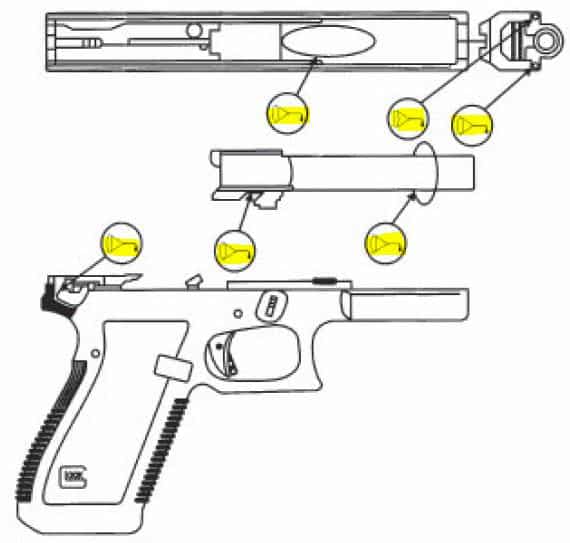We all recognize today how important it is to regularly and properly clean and maintain your handguns. The cleanliness and proper maintenance of your gun is directly related to its effective and efficient function for any use, as well as, perhaps, your survivability. It’s real inexpensive life insurance. However, just two decades or so ago some were advocating to NOT lube any handgun because it could make it jam, malfunction, and stop working. This is not true now. Today’s lubricants are far superior to previous ones and their sticky and hard-setting paraffin. Reliability, accuracy, and durability of firearms are certainly influenced by proper maintenance. One of the questions I get asked regularly by students is “Where do you lube the handgun?” They want to know the main points to lubricate. Where are the specific locations where you put lube? Do you use oil or grease? How much lube do you use? What kind? So, here are my ideas in brief, summary form and strictly my opinions. Others may not agree with me or think it overkill, but I know what has worked for me over the past 45 years or so.
Certainly, you lubricate almost every metal part of the handgun, especially if you see signs of wear and shiny contact spots. Know that I am not a certified pistol armorer or gunsmith. Some handguns, like a 1911, may require a different lubrication approach and different lubrication points. I tend to lubricate my 1911s more often for crud buildup. However, one tendency for shooters is to over-lubricate their guns. Old school thinking was to very thoroughly oil all components of your gun (just short of dipping and soaking the entire gun in an oil vat), then oil them some more, and then oil them some more. I even recall the first handgun I received as a kid from my Dad back in 1960 and how slippery and excessively oily it was, almost sliding out of my hand. I learned the hard way that excessive oil attracts a lot of dirt, dust, grit, unburned powder, and carbon fouling…. and that usually only ONE DROP per area smeared around there is sufficient. Like Mickey Mantle said in the old Brylcreem Advertising Hall of Fame jingle “A little dab’ll do ya!” So, a very light coat and small amount. I do not use a Q-tip swab because it leaves cotton fiber residue. Of course, one person’s definition of “excessive” may not match another’s.
I re-lube my pistols regularly and certainly just right before use, if they have been stored for about 3-4 weeks or more without use. Oil especially has a tendency to seep out, dry up, dissipate, and not be where you want it to be. Some even say to re-oil after every 50 rounds to ensure proper functioning, but I do not. I believe that most quality pistols of today which are clean but free of most lubricant will function through several magazines before a problem or stoppage is encountered, but I still do NOT wait until after that second range trip to lubricate my guns.
My personal handgun maintenance policy is to clean and properly lubricate my handguns after EACH range trip use (no matter how many rounds were fired– which is usually 200 rounds or so) and within 24 hours, before excessive lead hardening and buildup occurs, for ease of cleaning, protection, and preservation.
Just like some prefer only synthetic oil (like Mobile 1 motor oil or sewing machine oil), others want only high temperature grease (like found in auto stores for wheel bearings). Your preference. Personally, I have observed that grease does stay put where you apply it, but that also means that it will be in place to attract more dirt, grit, and grime, etc. Some strongly believe that grease should be the main lubricant and others that oil should be mostly or solely used. There are many factors to consider and it boils down to mostly personal preference I believe. Grease is especially useful for the high friction-high load areas, such as the bore area of the slide and the rails. Some say it is a little too heavy for the small parts which function with only a light friction-light bearing load.
Recognize that colder temperature thickens most oils and greases and as the lubricant becomes thicker, the energy required to move a pistol part becomes greater. If the energy is not sufficient, the shooter will encounter a malfunction or stoppage because of the thickened lubricant. Also, severe dust conditions can cause problems with lubrication, so protect your pistol from dust daily as much as possible. I know that In the desert the dust may be as fine as talcum powder and blow into everything, mix with the lubricant, and form a paste that will cause accelerated wear and problems. It may combine with oil and form a very thick, tacky mixture that can actually stop the function of firearms. As you shoot, your pistol is getting dirty with carbon fouling and residue and the lubricant will keep this fouling and gunk in a suspension with it instead of becoming hard and slowing down cycling, if it were dry.
In Florida and especially in the Summers, it can get very hot, so I use the 10W-40, 20W-50, or 5W-30 grade motor oils mostly for lubrication. They have nice thicker viscosities that won’t run off gun metal and do not dry up as quickly, like some of the branded and expensive gun oils. I have found them to be just as effective at a lower price. I do prefer synthetic oil and regularly use low-cost Wal Mart Super Tech Full Synthetic SAE 5W-30. Also, I buy high temp (and low-cost) wheel-bearing/disc drum grease from my local auto supplies store– about $6 for a 1 pound can) for occasional use with a syringe on high-contact friction spots. For me, it lasts a long time, is low cost, is very temperature resistant for a hot gun, and I have had my grease for over 20 years already. Recognize that I do know it certainly is necessary to lubricate a revolver also, but this article will focus only on semi-automatic pistols. There are similar strategies with different lubrication spots between pistols and revolvers. Perhaps, the revolver at another time.
After you make certain your handgun is UNLOADED and disassemble your pistol, there are three main areas that need lubrication: the slide, the barrel, and the frame and its parts and mechanisms. Each area with multiple spots to lubricate and spread around the lube.

SLIDE:
1. One drop on inside of each slide rail groove and one on center rail that cocks the hammer;
2. One drop on inside front of slide near ejection port where slide & frame touch on both sides (to reduce friction);
3. One drop near the middle of the slide inside where the locking lug recesses for the barrel contact are located; also all along the curved surface near the locking lugs;
Note: Wipe off any excess lube that might run out at the rear of the slide/frame area
BARREL:
1. One drop on front of barrel hood (which is exposed in the ejection port) on top where it contacts the slide;
2. One drop near middle of barrel on each of the barrel locking lugs;
3. One drop near barrel tip at outside front of muzzle (to ensure barrel bushing area is lubricated during firing) then smear it all around the barrel;
FRAME:
1. One Drop near rear of frame by trigger bar, trigger spring, and Sear where the trigger bar contacts the trigger Connector;
2. One drop on the Disconnector;
3. One drop on Slide Stop pin;
4. One drop on Recoil Guide Rod (not on Recoil Spring);
5. One drop on Magazine Release button (each side if ambidextrous).
Note: If you have a series 80 style pistol, you might want to apply a very light coat of lube to the Firing Pin Plunger hole and to the Firing Pin hole. However, some disagree with this claiming over time it can clog the Firing Pin Channel causing problems. Your decision. Some handgun designs definitely keep gunk and buildup out of the channel better than others. My layman experience says that most Firing Pins can last to about 1000 fired rounds before being replaced or thoroughly cleaned. Of course, frequency of use is a major determinant. Simple Concept: If you do not lube your Firing Pin Channel, crud will stop sticking to it and causing reliability problems.
Magazines
Do not forget magazine maintenance. Remember the WARNING: Magazine Spring, Follower, and inner floorplate are under spring tension and can cause eye or other injury if not controlled during removal. Be careful. Shooters should disassemble and clean their magazines regularly, usually at the same time they clean their pistol or as use demands. However, some handgun manuals say that mags do NOT normally need to be disassembled and cleaned each time your pistol is cleaned. They suggest less frequent cleaning intervals for mags, about every 3-4 months, unless the mags have been exposed to dirt, sand, or other adverse conditions or inspection indicates the need. So if you drop your mags in a speed reload to the ground in sand and dirt, you probably need to clean them more regularly. Magazines need only the very smallest, minimum of lube… IF ANY AT ALL. The key words are VERY, VERY LIGHT MAGAZINE LUBRICATION… and not internally. Personally, I do NOT lubricate my magazines at all and do wipe them down to get the excess off both inside and outside, along with wiping down the breech face, after cleaning and lubrication. If you are going to be shooting pistol matches and will be dropping your mags in the dirt, you probably should use NO lubricant on your mags at all. Any lubricant will pick up and hold gravel and dirt which will cause the ammo to stick in the mags, causing failure to fire and contamination of primers.
Some Cautions

Too much lubricant collecting inside the gun’s Firing Pin Channel over an extended period of time may lead to problems. People who don’t regularly maintain their guns can end up with clogged Firing Pin Channels and perhaps at least slow fires. Personally, I do not put lube in the Firing Pin Channel, around the extractor, on the breech face, nor on the feedramp. If I use lube in the barrel chamber, I always wipe away the excess and almost all of it before putting the gun away. I look for gunk in the channel and if I see it I clean it out. These areas should be left clean from lubricant to prevent problems. It could cause a shell casing to become attached to your gun. In some cases it may cause the breech to deform and rupture due to the pressure created between the casing and the chamber. No oil or lubricant here.
Also, as I sadly discovered, frequent excessive oiling of grips can cause deterioration and rotting of your wood grips and in cold weather might somewhat freeze your action.
If you are going to store your pistol for a long time over months, a coat of Grease MAY be applied to the chamber and bore for storage, BUT…
CAUTION: This is FOR LONG-TERM STORAGE ONLY IN AN UNLOADED CONDITION. The Grease MUST BE REMOVED before you load and fire the pistol. Failure to remove lubricant from the chamber and bore can cause excessive pressure which can cause damage to the firearm and yourself! Be very careful if you decide to do this!
I hope this information about proper maintenance, cleaning, and lubrication of pistols will help you maintain your handguns so they will effectively function and enhance their reliability and accuracy, while keeping you safe.
Continued success!
Photos by Author and Glock Instruction Manual




















